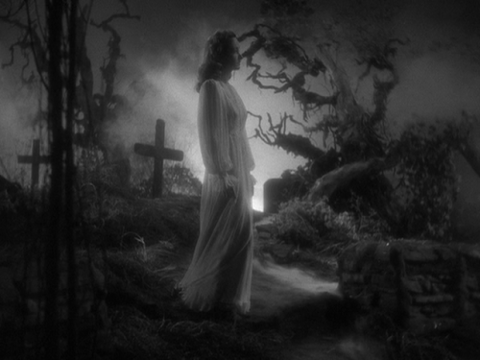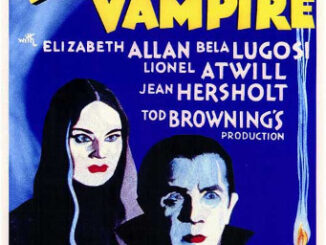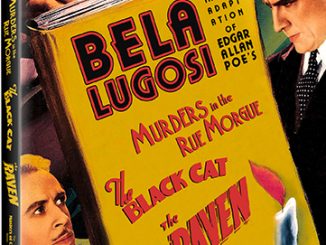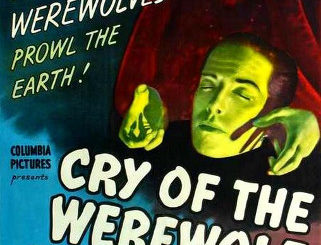The Return of the Vampire
Directed by: Lew Landers
Written by: Griffin Jay, Kurt Neumann, Randall Faye
Starring: Bela Lugosi, Frieda Inescort, Matt Willis, Nina Foch
USA
AVAILABLE ON BLU-RAY [REGION ‘A’ ONLY] AND DVD
RUNNING TIME: 70 mins
REVIEWED BY: Dr Lenera, Official HCF Critic
1918 during World War I: 17th century vampire Armand Tesla stalks London. Professor Walter Saunders and Lady Jane Ainsley find the monster’s crypt and stake him, an act that also causes the vampire’s werewolf assistant Andreas to be cured of his curse. 1942 years later during World War 2: a bombing raid occurs which exposes Tesla’s corpse. Some workers, believing the stake to be bomb shrapnel, remove it. Tesla promptly regains his control over Andreas and sets out to avenge himself on Lady Jane.…
Me being me, I was most excited to obtain a Bela Lugosi vampire film that I’d never seen – or so I thought. As the film played, vague memories came back to me of one of the umpteenth times I’d snuck downstairs at around midnight as a kid and watch a vintage [and occasionally not so vintage – my first viewing of Halloween was this way and bloody hell I was terrified both during and after] horror movie sat right up close to the TV set as I couldn’t have the sound turned up loud. It was the talking werewolf that I recognised more than anything else – in fact he doesn’t just talk, he wears clothes and is often seen carrying the laundry in a package tied up with string for his boss. This sure was one different werewolf from the ones I was familiar with. But how does it fare as a film? Well for a start it’s fairly similar to the Universal films that were coming out around the same time, and despite the oddities of its werewolf I would imagine that I mistook it for a Universal effort when I first it, as I reckon many people do who miss the beginning of the opening credits. Though not quite as action packed, it’s just as fast paced as the same year’s Frankenstein Meets The Wolf Man, while parts of it are as creepy and atmospheric as Son Of Dracula, also a 1943 Universal. I would imagine it satisfyingly frightened audiences of the time. Lugosi is at his very best here – in fact those wanting to check out why he was- and still is – such a fan favourite are perhaps better off watching this film than Dracula. And there are more strong female roles than you’d expect for the time. However, it looks a tad cheap and shoddy at times, and certain plot elements and characters really could have done with being given more screen time.
Columbia bought the rights to Kurt Neumann’s short story Vampires Of London and intended this to be a sequel to Dracula, with Lugosi returning as the Count [ a character he only ended up playing three times despite being as associated with the role as much as Christopher Lee]. Neumann was to direct and Griffin Jay to write the script. However at the time Universal held the sole rights to the character, and threatened a plagiarism suit, so Jay had to change a few things and Paramount further placated Universal by allowing one of their contract players to appear in a Universal film. Delays in getting the production off the ground caused Neumann to leave and be replaced by Lew Landers who’d directed The Raven for Universal. The Columbia Gower studios were too cramped to shoot the cemetery scenes, so those were filmed at Fine Arts Studio. According to some, Lugosi would actually have naps in his character’s coffin on set because he was tired from shooting The Return Of The Vampire during the day and acting on stage in Arsenic And Old Lace in the evening. The release was held back for two months so as not to compete with Son of Dracula, a good move as it was a strong money maker at the box office. In the UK, two shots of Tesla’s death were removed by the BBFC. The film would be the last where Lugosi would receive top billing by a major Hollywood studio. A sequel entitled Bride Of The Vampire was planned with Lugosi and Foch returning, though it eventually metamorphised into the lycanthrope movie Cry Of The Werewolf – and that’s one I certainly haven’t seen though intend to very soon!
“The imagination of man at times sires the fantastic and the grotesque. That the imagination of can soar into the stratosphere is attested by—-” – and we go into the titles, which take place over quite an effective vampire attack scene introduced by a rapid zoom out from the female victim’s face, the sort of thing you’d often see much later but quite unusual for the time. And then the camera pans over a simply wonderful graveyard set with a swamp right by it and fog wafting over, one possibly more beautiful than any in the Universal films. We switch to the victim being admitted to the clinic of Lady Jane Ainsley and her colleague, Professor Walter Saunders, who are both baffled, though the book ‘The Supernatural and its Manifestations’ by a certain Armand Tesla is handily nearby. Meanwhile the vampire, unable to finish off his previous victim who dies after describing a disturbing dream, bites Saunders’ young granddaughter Nikki instead, proceeded by the usual doors opening and fog coming into the room. Now this is something I was really surprised at, even if we don’t see the actual bite as expected, and even if the sexual aspects of vampirism are only subtly hinted at. I guess they got away with it in 1943 because the victim survives. Saunders and Jane rather quickly find the vampire, making sure it’s him by holding up a mirror [cue quite a startling shot of the upper half of the body with no head!] first. The blows of the stake also hit Tesla’s werewolf servant Andreas who becomes human again and an assistant in Jane’s laboratory, after which you wouldn’t know that you flash forward twenty-four years considering that Jane barely looks a day older! Scotland Yard detective Sir Fredrick Fleet reads the deceased Saunders’ account of these events, and informs Lady Jane that if the body they staked was alive at the time, she will be charged with murder.
Jane’s certain that Sir Frederick will find that Tesla’s body has not decomposed, proving he was a vampire [this was before vampires decomposing became the norm], and she and her son John agree to keep this information from John’s fiancée, who is – Nikki. But Tesla is freed during a bombing raid and in no time at all kills someone and had Andreas back under his control. Andreas then murders Hugo Bruckner, a scientist recently escaped from a concentration camp who had arrived in England to work with Lady Jane, so that Tesla can impersonate impersonate Bruckner and infiltrate the Ainsley household, leading to a major plot hole – why on earth doesn’t Jane recognise Tesla seeing as she was with Saunders when he staked him and saw him in his coffin? Of course many of the Universal films also had examples of this kind of sloppiness. Things then progress very much like Dracula, though there’s a slight element of self-aware humour, like when Tesla tells the receptionist of the hotel he’s staying at “nobody must disturb me, I sleep during the day” in addition to two typical comical gravediggers. And we never had Renfield turn the tables on Dracula, though it’s a shame that Andreas does it in his human form. In fact, while I kinda like the different werewolf [even if he does throw a punch], and the makeup [partly reused in The Werewolf] is decent except for the silly nose and actually a bit more wolf-like than Lon Chaney’s, he doesn’t really do much at all except serve Tesla, a task which could easily have been handled by a mere human – who would certainly have aroused a great deal less suspicion than a werewolf. And you have to laugh when two men mention how the person they were fighting turned into a “wolf”. Surely “wolf-like man” would have been more appropriate? Matt Willis does his best to suggest a nice guy fighting bestial urges though he could have done with more screen time.
Luckily Tesla is great, even if he only turns into a bat once, and is somehow able to walk around comfortably in a cemetery containing several crosses. We even see him get properly out of his coffin, even if it is from the back, while his grasping hand bursting through the ground must have given some 1943 watchers some nightmares and might be the very first scene of its kind. While more could have been done with the idea, the premise of the “depraved Romanian scientist” who was so obsessed with evil that he actually becomes a bloodsucker is a good one, Lugosi slightly tweaks his Dracula performance so that he seems a little more insane this time around. Even at 61 [funny how they say that Bruckner was 62 when they find out that Tesla is impersonating him and therefore can’t be him at all] his almost otherworldly presence is incredibly strong. They added a kind of echo effect to his distinctive accent which I think works really well and manages to be genuinely creepy when just heard calling “Nicki, I’m waiting for you, come to me”, and, seeing as he says he wants to make her his bride and take her back to Romania, this vampire appears to have actual romantic designs, albeit designs that disturbingly began when he saw her as a little girl. Nick’s attack on her fiancee, though cut away from, also has a perverse quality seeing as Tesla likes to watch. We barely spend any time with the boring romantic couple at all, which is great especially as Roland Varno is pretty insipid and the usually fine Nina Foch isn’t too good either. It’s Freida Inescort as Jane who most strongly carries the human side as long as you ignore an early scene where she speaks her lines far too quickly. Her confrontation with Tesla as she plays the organ is finely played by both her and Lugosi, and one just wishes it was longer. The climax is pretty good too, and – while the waxy Lugosi face as he supposed to burn isn’t too impressive – the decomposed aftermath is quite yucky looking for the time.
The idea of war bombings playing a big part in both the resurrection of the vampire and his destruction is neat, though otherwise you’d never know you were in England in 1942 and the way real war footage is edited in to the bombing scenes must have looked jarring even at the time. There’s a cramped feel to the proceedings, though the cinematography by L. William O’ Connell and John Stumar is very impressive, full of film noir-like use of darkness which is used especially well on faces [having black cover one side of Andreas’s face is obvious symbolism of course], and director Lew Landers tends to want to pan more than some of its contemporaries. Mario Castelnuovo-Tedesco’s score plays almost nonstop but its motifs tend to be forgettable though. One misses the touch of Hans J. Salter or Frank Skinner. Still, in general The Return Of The Vampire, while a little odd and unsure of itself at times, should please most fans of vintage horror, has its interesting aspects, and is pretty good fun.
Rating: 

















Be the first to comment